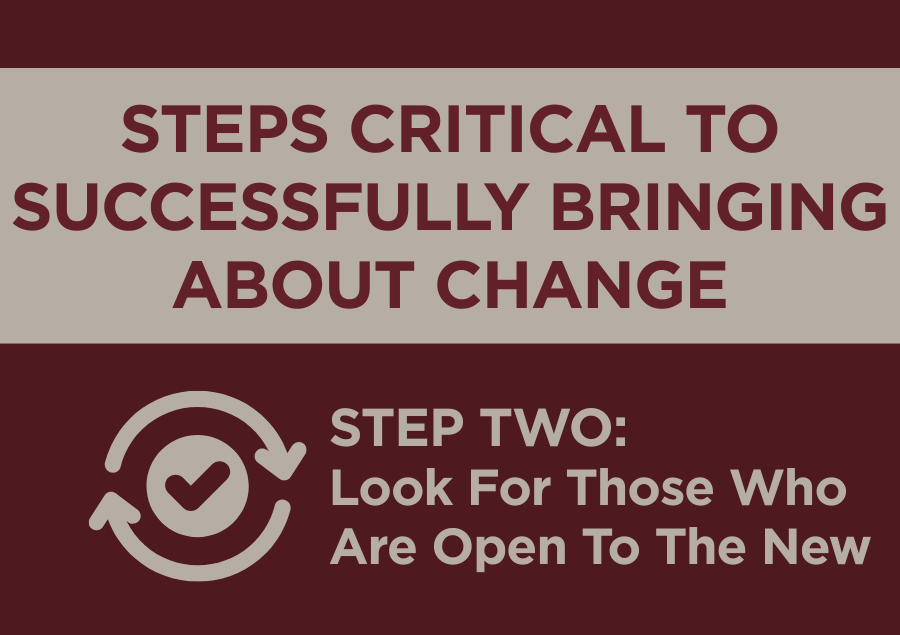
Tim O’Neill, Executive Director
Look For Those Who Are Open To The New
You probably know that there are those who are keen, even hungry for change. These are the kind of people who have a great affinity with Charles Kettering who once said “My interest is in the future because I am going to spend the rest of my life there.”
The famous “Diffusion of Innovations” Bell Curve indicates that probably 2.5% of people are innovators with a further 13.5% being early adopters. That’s around 16% of any group of people are looking to or at least open to try new things.
Then there are around 68% who will likely be open to doing things differently once they see that there isn’t great risk, that it makes sense and importantly that it should work.
A further 16% are the laggards who will be the last ones to change.
Now here’s a hint. Don’t try to introduce the new and bring about change by going to the laggards first! Don’t even try to do so with the 68% in the middle majority first. Instead identify and go first to the innovators and early adopters.
Nassim Nicholas Taleb developed and popularised the “Barbell Strategy”. Imagine a barbell in the gym with weights on either end but instead of the weights on each side being equal, 85% of the weight will be on one side and 15% of the weight on the other side.
In change theory, the 85% represents the majority of the people. They don’t look forward to change or trying new things. They want what is tried and tested; proven to work.
The 15% on the other hand represents those who are open to or even looking forward to the new and to change. They are risk takers.
Under the Barbell Strategy, the role of the leader is to keep the two groups separate, standing in the middle but holding firmly on to the mission and values. The reason the two groups need to be separated is that if the 15% was mixed in with the 85%, they would be in an environment that quashed innovation and risk taking. And they would probably cause anxiety amongst the 85%.
If the 15% came up with new ideas, they would hear of all the reasons why the ideas wouldn’t work or shouldn’t even be tried. “We’ve never done it that way!”, “What is wrong with what we have always done?”, “It won’t work, we tried something like that once”, “I’m not comfortable with this!”, “It’s not godly!”.
Lockheed Martin the American defence and aerospace manufacturer realised that for innovation to flourish, the innovators needed to be separated and developed a unit called “Skunk Works” who were located away from the main operations. They were charged with the responsibility of innovating and finding new technologies and ways. It was realised that nine out of ten ideas may fail but the one that succeeded could change everything. The U-2 spy plane, the SR-71 Blackbird, and the F-117 Nighthawk stealth aircraft are some game changing projects Skunk Works devised and developed – and the production line was able to produce.
So what can we learn from the Barbell Theory and Skunk Works? Perhaps it’s that we shouldn’t mix new wine and old wineskins together. The suggestion is that we should take the innovators and entrepreneurs and charge them with the responsibility of innovating new ways even if they fail. But if one new way might succeed, it could change everything!
When a new method has been developed as a working model, it can then be introduced to the 85% and in this way those in the middle and even then laggards can be exposed to new working models and methods.
Two questions to reflect on are:
- Who are the 15% in your church?
- How can you release them to innovate and try something new?
Perhaps you might look at one of the “10 Shifts To Birth Multiplication in Your Church or Plant” and give the innovators the responsibility of working on one of these shifts?
One thing that I know is that we can’t do what we have always done and expect different results. This maxim holds true to an even greater extent when the world and its culture is rapidly changing around us.
In such times when we must make the adjustments necessary to be faithful to the Commission and Commands Jesus gave us, I pray that we don’t settle for the old by saying that “The old is good enough.” Luke 5:39 (NET).
Tim O’Neill
Executive Director, Exponential Australia
